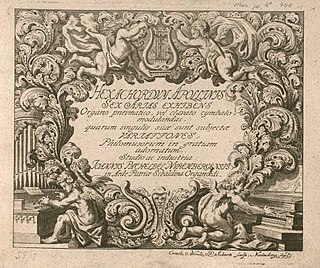Charles Theodore Pachelbel (baptized Carl Theodorus, also spelled Karl Theodor, on November 24, 1690; [1] buried September 15, 1750) was a German composer, organist and harpsichordist of the late Baroque era. He was the son of the more famous Johann Pachelbel, composer of the popular Canon in D. He was one of the first European composers to take up residence in the American colonies, [2] and was the most famous musical figure in early Charleston, South Carolina.
He was born in Stuttgart and baptized in the Evangelische Kirchengemeinde (Protestant parish) there on 24 November 1690, son of Johann Pachelbel and his second wife Judith Drommer. [1] The family moved to Gotha in 1692, then to Nuremberg in 1695. Nothing is known about Charles Theodore's life for 25 years after 1706, when his father died, except the fact that he probably lived in England for some time [3] (his name appears in a 1732 list of subscribers to a volume of harpsichord music published in London [4] ).
The circumstances of his emigration to the colonies are unknown. Pachelbel was living in Boston, Massachusetts by spring 1733, when he was asked to assist in the installation of the new organ of Trinity Church in Newport, Rhode Island. The instrument was donated to Trinity by George Berkeley, the famous philosopher. Pachelbel was subsequently hired as organist of the church and held the post until approximately mid-1735. In 1736 Pachelbel gave two public concerts in New York: on 21 January and on 9 March. Both took place in Robert Todd's house, an important tavern. [5] Pachelbel played the harpsichord, accompanied by local musicians and singers.
Pachelbel soon left for Charleston, South Carolina, where he spent the rest of his life. On 16 February 1737 he married Hanna Poitevin in St. Philip's Church in Charleston. The couple had at least one child, Charles, born on 10 September 1739. This could have been Pachelbel's second marriage, because traces of an older daughter have been found. [6] He actively participated in the musical life of the city: on 22 November 1737 he organized a concert of vocal and instrumental music, apparently the first public concert in the Charleston area; in February 1740 he succeeded John Salter as organist of St. Philip's Church; and in 1749, one year before he died, he opened a singing school. Pachelbel's death in 1750 was apparently caused by some sort of illness, referred to as a "lameness in the hands" in the documents. His wife outlived him by 19 years and died on 6 September 1769. There is no further record of Pachelbel's children.
Only a handful of works by Charles Pachelbel survive; the most famous is an aria God of sleep, for whom I languish. His Magnificat for double choir is performed with some frequency. The young Peter Pelham studied with him since Newport and followed him to Charleston; some of Pachelbel's compositions survive in Pelham's partbooks. Included in the list of Pachelbel's possessions compiled after his death are a harpsichord, a clavichord and collections of sheet music, but none of these seem to have survived.
Johann Pachelbel was a German composer, organist, and teacher who brought the south German organ schools to their peak. He composed a large body of sacred and secular music, and his contributions to the development of the chorale prelude and fugue have earned him a place among the most important composers of the middle Baroque era.

Toccata is a virtuoso piece of music typically for a keyboard or plucked string instrument featuring fast-moving, lightly fingered or otherwise virtuosic passages or sections, with or without imitative or fugal interludes, generally emphasizing the dexterity of the performer's fingers. Less frequently, the name is applied to works for multiple instruments.

Pachelbel's Canon is an accompanied canon by the German Baroque composer Johann Pachelbel. The canon was originally scored for three violins and basso continuo and paired with a gigue, known as Canon and Gigue for 3 violins and basso continuo. Both movements are in the key of D major. Although a true canon at the unison in three parts, it also has elements of a chaconne. Neither the date nor the circumstances of its composition are known, and the oldest surviving manuscript copy of the piece dates from 1838 to 1842.
Wilhelm Hieronymus Pachelbel was a German composer and organist, the elder son of Johann Pachelbel.
The Couperin family was a musical dynasty of professional composers and performers. They were the most prolific family in French musical history, active during the Baroque era. Louis Couperin and his nephew, François Couperin le grand, are the best known members of the family.
Christian Petzold was a German composer and organist. He was active primarily in Dresden, and achieved a high reputation during his lifetime, but his surviving works are few. It was established in the 1970s that the famous Minuet in G major, previously attributed to Johann Sebastian Bach, was in fact the work of Petzold. The sprightly melody was used in the 1965 pop music hit "A Lover's Concerto" by the American group The Toys.
The year 1690 in music involved some significant events.
The year 1679 in music involved some significant events.
Johann Gottlieb Goldberg was a German virtuoso harpsichordist, organist, and composer of the late Baroque and early Classical period. He is best known for lending his name, as the probable original performer, to the renowned Goldberg Variations of J. S. Bach.

Johann Erasmus Kindermann was a German Baroque organist and composer. He was the most important composer of the Nuremberg school in the first half of the 17th century.
Peter Pelham was an English-born American organist, harpsichordist, teacher and composer.
Joseph Payne was a British/Swiss German harpsichordist, clavichordist, organist and musicologist, whose worldwide reputation was based on his performances of music of all periods, though best known for his pioneering recordings of early keyboard music accompanied by his meticulously informative liner notes.

Hexachordum Apollinis is a collection of keyboard music by Johann Pachelbel, published in 1699. It comprises six arias with variations, on original themes, and is generally regarded as one of the pinnacles of Pachelbel's oeuvre. The collection includes a preface in which Pachelbel dedicates the work to Dieterich Buxtehude and Ferdinand Tobias Richter and briefly discusses the nature of music.

Erster Theil etlicher Choräle is a collection of liturgical organ music by Johann Pachelbel, published during his lifetime. It contains eight chorale preludes in seven different styles.

Johann Adolph Scheibe was a German-Danish composer and significant critic and theorist of music. Though much of his theoretical work survives, most of his compositions are lost, though the extant ones demonstrate a style between the Baroque and Classical periods.
Style brisé is a general term for irregular arpeggiated texture in instrumental music of the Baroque period. It is commonly used in discussion of music for lute, keyboard instruments, or the viol.
As it has with every aspect of Charleston, South Carolina culture, the Gullah community has had a tremendous influence on Music in Charleston, especially when it comes to the early development of jazz music. In turn, the music of Charleston has had an influence on that of the rest of the country. The geechee dances that accompanied the music of the dock workers in Charleston followed a rhythm that inspired Eubie Blake's "Charleston Rag" and soon later James P. Johnson's "The Charleston", as well as the dance craze that defined a nation in the 1920s. "Ballin' the Jack", which was the popular dance in the years before "The Charleston", was written by native Charlestonian Chris Smith.

"An Wasserflüssen Babylon" is a Lutheran hymn by Wolfgang Dachstein, which was first published in Strasbourg in 1525. The text of the hymn is a paraphrase of Psalm 137. Its singing tune, which is the best known part of the hymn and Dachstein's best known melody, was popularised as the chorale tune of Paul Gerhardt's 17th-century Passion hymn "Ein Lämmlein geht und trägt die Schuld". With this hymn text, Dachstein's tune is included in the Protestant hymnal Evangelisches Gesangbuch.